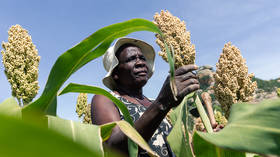Majority of people in African state threatened by hunger

More than half of Zimbabwe’s population will require food aid this year due to a severe drought that has caused widespread crop failure, the southern African nation’s government has announced.
Between May 2024 and March 2025, 6 million people in rural areas and 1.7 million in urban regions, totaling 51% of the country’s population, will need assistance, the cabinet said on Tuesday, citing a report by the Zimbabwe Livelihoods Assessment Committee (ZIMLAC).
The figure excludes an additional 4.5 million people who will require school meals, according to ZIMLAC.
“Government is working hard to ensure that no one will die of hunger,” the cabinet stated in a message published on the website of the country’s Information Ministry.
“Going forward, Zimbabwe’s food security thrust will center on the reduction of reliance on rain-fed food production by strengthening initiatives such as climate-proofed agriculture, with a focus on conservation agriculture and expanding the area under irrigation,” it added.
Zimbabwe is one of the southern African countries hardest hit by the El Nino-induced drought, which the government says is the worst it has experienced in 40 years. Zambia and Malawi are also facing food shortages this year. El Nino is a naturally occurring weather phenomenon that disrupts wind patterns, resulting in warmer ocean surface temperatures in the eastern and central Pacific.
Most provinces in landlocked Zimbabwe have experienced crop failure since November, with hotter areas writing off harvests of corn and other staples.
The country declared a national state of disaster last month, with President Emmerson Mnangagwa announcing that his government needs $2 billion in aid to feed millions facing hunger.
According to the latest crop assessment presented to Zimbabwe’s cabinet this week, cereal production in the African country is expected to fall by 77% from 2,579,237 metric tons to 744,271 metric tons during the 2023-2024 summer season.
Apart from the impact on crop farming, the “El Nino-induced weather conditions on water supply and grazing availability for livestock have resulted in the loss of 9,941 cattle at the beginning of the 2023-2024 season,” the report stated.
The UN International Children’s Emergency Fund (UNICEF) has launched an appeal seeking $84.9 million to provide life-saving interventions to 1.34 million Zimbabweans, including 866,000 children, describing the situation as a “complex humanitarian crisis.”
Zimbabwe was among six African countries that received 25,000 tons of humanitarian wheat from Russia in February as part of Moscow’s commitment to assisting food-insecure countries in fighting hunger.














